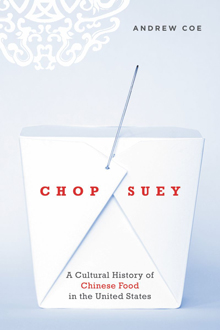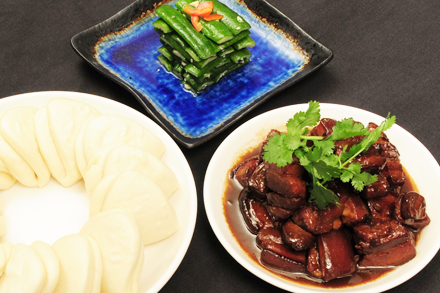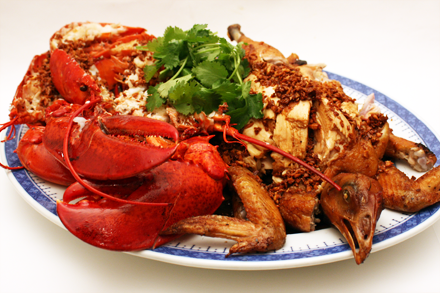
Like many immigrants to America I constantly search for food of my homeland. This search continues even now after more than thirty years. When I first arrived in the U.S. during the 1970’s the most common Chinese food was still chop suey. I remember being horrified when I was served chop suey as Chinese food at my college dormitory. Not only was it unrecognizable, but also tasted positively vile. I wondered how Chinese food had turned into this mess. Chop Suey: a Cultural History of Chinese Food in the United States, a new book by Andrew Coe, helps answer this question.
Coe starts his narrative with the very first American’s contact with Chinese food and customs. In 1784 Samuel Shaw arrived in Canton aboard the Empress of China and became the first American to join the many Europeans trading in China. Their attitudes towards Chinese food were typical of foreigners. Coe says the traders described the food as “putrified garlic on a much-used blanket”. They found Chinese food and dining customs to be exotic, nauseating and generally unpalatable.
The Chinese had very similar reactions to Western food. A young Chinese of the period described his impression of European food as, “Dishes of half-raw meat … placed at various angles of the table; these float in gravy, while from them pieces are cut with swordlike instruments and placed before the guests. Really it was not until I beheld this sight that I became convinced of what I had often heard that the ferocious disposition of these demons arises from their indulgence in such gross food…” This was not a good beginning for culinary exchanges between America and China.
The California gold rush ushered in the first major wave of immigration from China to America. White prospectors’ racism and fear of competition created a hostile environment for the Chinese. It is against this political background according to Coe that negative reactions to Chinese culinary culture continued to be reinforced. It was rumored that cats and mice were common Chinese foods. What I find most intriguing is that Coe found evidence of elaborate Cantonese style banquets being prepared by master chefs using imported quality ingredients to serve to the Chinese elite of San Francisco. This assertion completely contradicts my understanding that the only Chinese food available in California at the time was prepared by the almost exclusively male laborers who did not know how to cook well and only had access to local Western ingredients.
It was not until the 1880’s, Coe suggested, that chop suey was discovered by the Bohemian society of New York. Forty years after the initial migration of the Chinese to California they moved east to New York to escape local persecution. The restaurants of these immigrants were discovered by the New York bohemians as exotic food and moderately priced. But what triggered the popularity of chop suey was the visit of a Chinese emissary Li Hongzhang to New York, where he was reportedly to have enjoyed chop suey even though in reality this was not the case. Chop suey houses sprouted everywhere. The success of these chop suey houses, Coe wrote, became the blueprint of Chinese restaurants that proliferate in America: serve plain familiar food at low prices.
Throughout the book Coe illustrates how politics has hindered the development of Chinese cuisine in America. The early bias against Chinese food inhibited the importation of Chinese ingredients and the Chinese Exclusion Act of 1882 stopped the influx of Chinese immigrants. Chinese people became isolated in enclaves in large cities such as San Francisco. Other laws limited ability of the Chinese to work outside of Chinatown leaving them to operate restaurants and laundry establishments.
Only after the repeal of the Chinese Exclusion Act and the passage of the Immigration Act of 1965 did things begin to change. A group of master chefs, who fled communist takeover of China, immigrated to the U.S. and opened restaurants serving dishes from unfamiliar regions like Sichuan and Hunan renewing interest in exotic Chinese cooking. President Nixon’s visit to China popularized the Peking duck and created a spike of interest in all things Chinese. In the end though, Coe concludes that a majority of the American public is still conditioned to cheap, plain and familiar Chinese food and that Chinese restaurants continue to adapt their cooking to cater to them.
With thorough research and entertaining narratives Coe has succeeded in creating a book that is familiar and fascinating at the same time. This is a book that anyone who is interested in Chinese food in America should not be without.
I had a chance to meet Andrew Coe recently to discuss “Chop Suey.” In my next post I will share the highlights of our conversation.






I am lucky to live in Los Angeles near the areas of Monterey Park and Alhambra where you can find very good Chinese food. Many have even said very authentic Chinese food. But I have read articles explaining the history and Americanization of Chinese food and find it very interesting. GREG
Been a long time since I bought a Chinese cookbook, now I may have to add another to the collection.
That’s is a great background the finding of Chinese-American or American-Chinese food. I found a great resource on making Chinese food with audio, video, and multi-media presentations. You can visit them at http://www.wokfusion.com/blog. I know you’ll enjoy it and much as I do. Diana
Thanks so much for this. Definitely going to pick it up. 😀
+Jessie